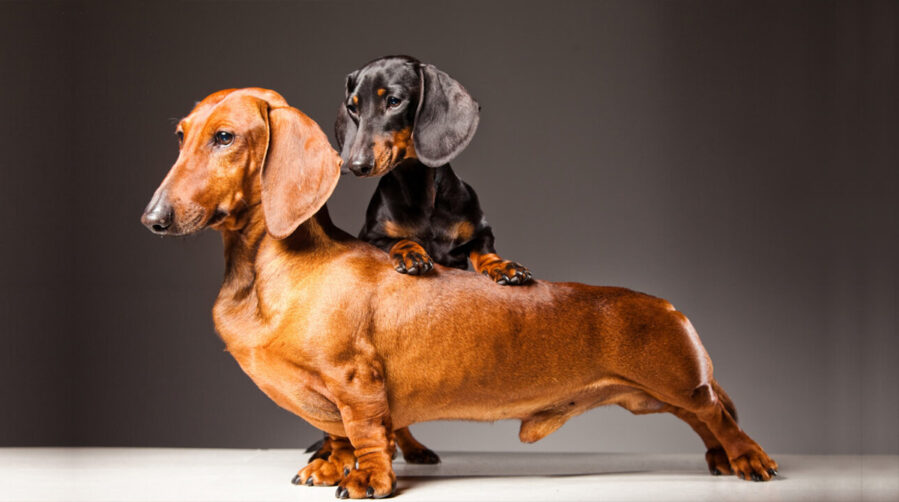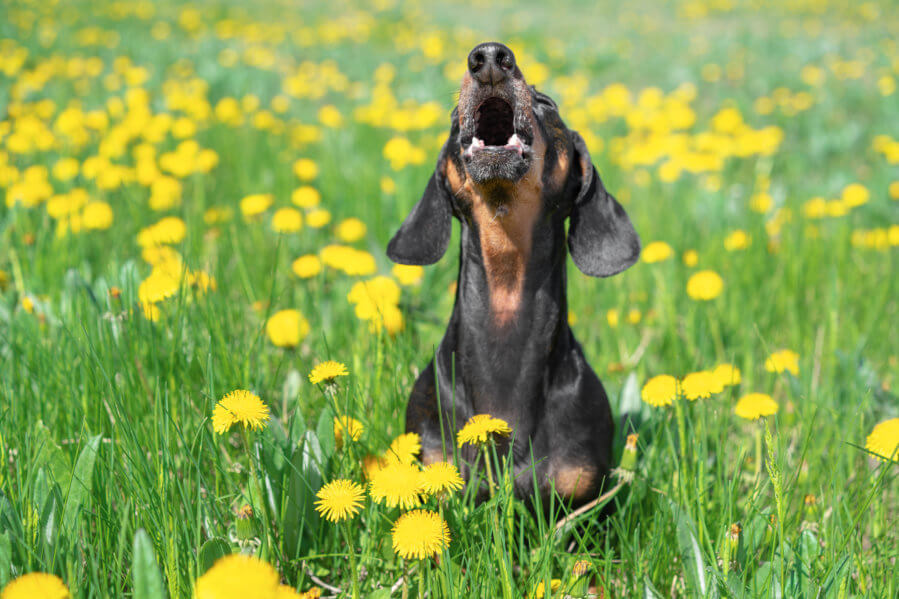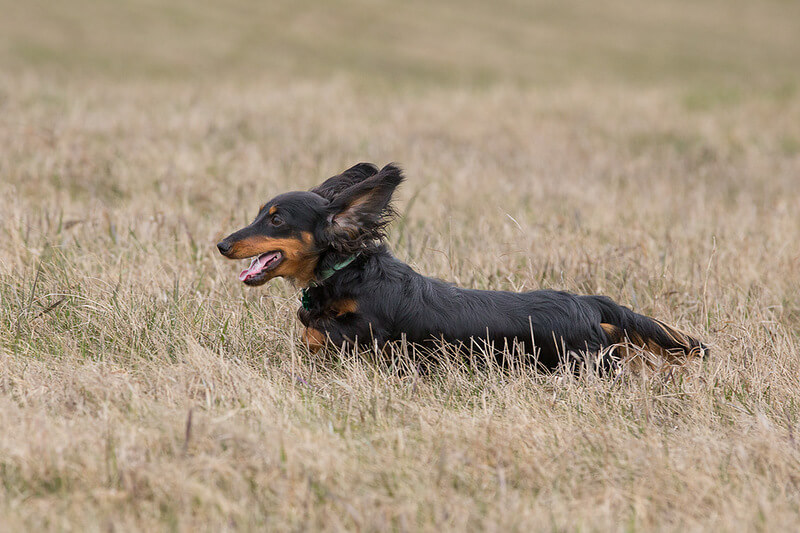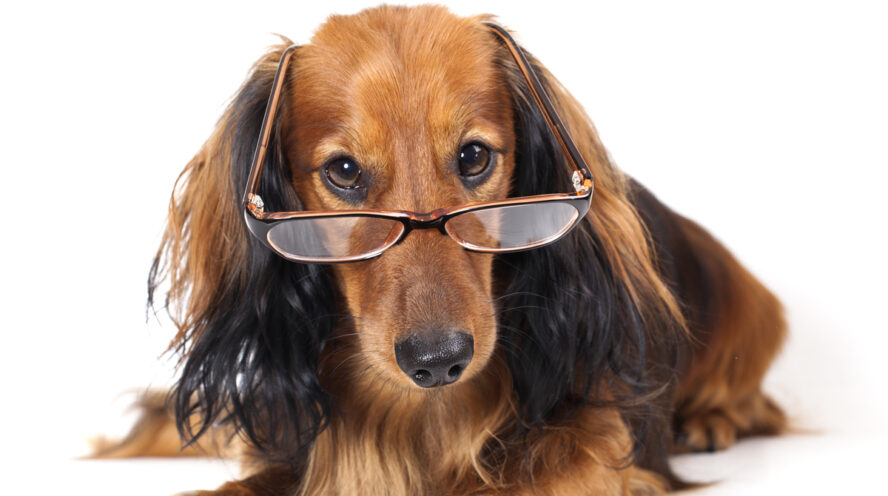Dachshunds are ranked as 12th in popularity out of 197 dog breeds recognized by the American Kennel Club, and for a good reason! These funny dogs are stealing the hearts of more and more people. You cannot pass by one of these goofballs – giant spirits trapped in small and oddly proportioned yet comically cute bodies.
Dachshunds’ popularity is only growing worldwide, making people interested in dachshund facts and history.
Popularly known as Teckels or Weiners, dachshunds are skilled hunters and friendly companion dogs.
These little dogs are full of surprises, and are so many things about dachshunds that are truly fascinating! Keep reading to learn the top 20 Dachshunds breed facts every Dachshund fancier should know!
Dachshund Fact №1 Dachshunds might have Egyptian roots
When thinking of Dachshunds, the first thing that comes to mind is the goofy-looking body. The second thing is its German origin. The Dachshund’s German history is over 600 years long, which is why we always link the famous “sausage dog” with Germany.
However, newer evidence suggests that the breed’s history does not start in Germany – it does not even begin in Europe. Namely, the dachshund’s origins can be traced to North Africa, or better said – Egypt!
The historians discovered that Egyptian engravings inside several pyramids depict short-legged hunting dogs, much similar to the modern dachshund. A group of archeologists also found remnants of mummified Dachshunds in a few Egyptian burial urns.
The evidence is credible, which only adds to the mystery of how the ancient Egyptian Dachshund ancestor found its way to the old continent and marked its incredible evolutionary history right in Germany.
Fact №2 Dachshunds have different names in different countries
Dachshunds are known by many different names. Usually, when referring to these dogs, we affectionately call them Doxies or use one of the two popular monikers – “wiener dog” or “sausage dog.”
In the United States and the United Kingdom, the breed is known by its official name – the dachshund, derived from the breed’s classification in the Hounds group.
In Germany, the breed is often called by its translational name – the “badger dog”. However, the Germans have few more names for their native dog. They also call Dachshunds “Dachs Krieger” and “Dachs Kriecher,” which translate to “badger warrior” and “badger crawler,” respectively.
Finally, the beloved and funny-looking dachshund goes by several other names, including Sosis, Jamnik, Bassotto, Perro Salchicha, Tax, Weenie Dog, Takca, Teckel, Badger Dog, and Wiener-Dog. These names are used in the different countries where Dachshunds are popular.
Read more in our article “Dachshund nicknames.”
Dachshund Fact №3 Dachshunds come in two sizes and three coat types

Dachshunds come in two different sizes – standard and miniature. The standard dachshund is 8-9 inches (20.3-22.8 centimeters) tall at the withers and weighs between 16 to 32 pounds (7.2 to 14.5 kilograms).
On the other side, the miniature dachshund is 5-6 inches (12.7-15.2 centimeters) tall at the withers and weighs less than 11 pounds (less than 4.9 kilograms). In Germany, there is also Rabbit Dachshund, which is a smaller version of a mini dachshund.
There are three different coat types in dachshunds, and all of them originated at separate times. At first, all dachshunds were smooth-haired. One of the theories states that this unique, smooth-haired variety resulted from breeding the Pinscher with the Miniature French pointer.
Later on, the smooth-haired Dachshunds were mixed with other dogs, and the mixtures resulted in two new coat varieties – wirehaired and long-haired. The oldest type – the smooth-haired dachshund, is still the most popular type.
Read more in our article “Dachshund Colours, Sizes and Physical Characteristics.”
Dachshund Fact №4 Dachshunds are the symbol of Germany
Because of its close association with Germany, today, the dachshund is considered its symbol. Many political cartoonists even portray a Dachshund when trying to mock Germany.
However, being widely associated with Germany took a significant toll on the breed. Namely, used in plenty of propaganda papers during WW I, the breed experienced an extreme decrease in popularity once the war was over. In an impressive PR stunt to save the dachshund breed, the American Kennel Club rebranded Dachshunds into “badger dogs.”
Regardless of the historical events during and following WW I, Germany remained faithful to its association with the dachshund. To prove its loyalty to this breed, Germany chose a colorful Dachshund as its official mascot for the Munich Summer Olympic Games in 1972.
The dachshund was named Waldi, and this was the first time in history since the Olympic Games featured a mascot. Plus, the marathon’s route was following a Dachshund shape.
Dachshund Fact №5 Dachshunds are versatile hunters both below and above ground
Native to Germany, the Dachshunds belong to the Hound Group (according to AKC Classification) or the Scent Hounds Group (according to UKC Classification).
It took many years of careful selective breeding to create the dachshund – the only breed the American Kennel Club recognizes as versatile hunter both above and below ground.
Experts still debate whether the dachshund’s initial purpose was to hunt above or below ground. While some experts believe the initial intention was larger game baiting and hunting, others believe it was pursuing and exterminating badgers.
If we consider the breed’s name and characteristics, the second theory may seem more logical. Simply put, the name Dachshund literally translates to “badger hound”- the body anatomy allows entering dens and burrowing, and the brave spirit gives the courage to take on a 15-pound mammal.
However, in practice, Dachshunds also show a unique hunting skillset when baiting land animals, mainly game and boars.
So, until further evidence suggests otherwise, we can say that Dachshunds are efficient hunters both above and under the ground.
Dachshund Fact №6 Dachshunds are skilled and creative diggers
True to their earth burrowing and badger hunting heritage, modern Dachshunds enjoy making moonscape craters in the backyard. They can even create entire underground labyrinths and tunnels.
When it comes to the moon craters and labyrinths, Dachshunds are not to blame – digging is in their nature. In fact, the dachshund’s body is designed specifically for this purpose. The weirdly long body, the sharp-ending, pointed nose, and big powerful claws are the perfect digging tools.
However, not all Dachshunds dig because of their genetic wiring. Some Dachshunds dig because they are bored, and digging can be quite entertaining for them. Therefore, we advise you to exercise your dachshund and keep it physically and mentally stimulated.
Dachshund Fact №7 Dachshunds can wreak havoc on your eardrums

Saying that Dachshunds bark a lot is an understatement – they are a vocal nuisance and can wreak havoc on your eardrums. Once again, this trait is derived from the dachshund’s hunting heritage. Namely, all hunting breeds bark – some more and some less. The dachshund belongs to the group that barks more.
Not only do Dachshunds bark a lot, but their bark can be quite loud and disturbing, particularly in comparison with their diminutive size. When the dachshund barks, the entire neighborhood will know.
Dachshunds also bark when they feel anxious, excited, or merely bored. Dachshunds are extremely sensitive to changes in their living environment, and whenever they feel confused about it, they focus on something they know well – excessive barking.
Treats are an effective way of bribing a Dachshund to stop barking. Just be careful – you might end up with a quiet but obese Dachshund.
Read more in our article “Do Dachshunds Bark A Lot?.”
Dachshund Fact №8 The first cloned dog in Britain was a Dachshund
Cloning pets is still a high-end, novel technology, but scientists expect it to become a routine procedure in the near future.
Rebecca Smith from Battersea, Great Britain, owns a contest-winning Dachshund named Winnie. When Winnie was 12 years old, Rebecca decided she wanted her dog cloned, and with the help of South Korean team of scientists, she got what she wished for – a mini replica named Mini-Winnie.
The puppy spent the first five months of its life in a laboratory in South Korea, and then it was shipped to Rebecca. Winnie and Mini-Winnie’s resemblance is impressive – they both have the same color markings, and their tails are crooked at the same spot. What is more, the two dogs hit it off immediately – like they have known each other since forever.
Dachshund Fact №9 The curved tail and floppy ears are not purely decorative

Put the disproportionally long body aside, and the Dachshund breed’s hallmarks are the long floppy ears and curved tail. However, it is a less known fact that these features are not naturally occurring – they are a deliberate result of targeted and careful breeding. Each feature has two unique and practical purposes.
The purpose of the ears is to touch the ground and pick up scents from it. The scents picked up by the ears are easily transferred to the nose and then analyzed. The ears are inverted downwards to prevent foxtails and grass blades and seeds from entering the ear canal and causing painful ear inflammations.
The long curved tail’s purpose is to make it more easily visible while the dog is hunting in tall grass. Plus, when the dachshund follows its prey into a tunnel and gets stuck, the owner can easily pull it out by pulling the tail.
Fact №10 Dachshunds need special beds, ramps and stairs
Dachshunds have rather a specific anatomy – they have short and fragile legs combined with a comparatively long spine. Due to their disproportional height to length ratio, the dachshund’s spine and back are susceptible and can easily get injured. The risk of injury is highest when dogs jump. Therefore, Dachshunds need specifically designed beds, ramps, and stairs.
Therefore, the ideal dog bed for Dachshunds will be one that does not require jumping to get in and out. The bed has to be orthopedic to give appropriate spine support.
Another essential feature of the Dachshunds’ perfect dog bed is a blanket for burrowing into since Dachshunds love to burrow. As an alternative, a cavern type of bed can be the right choice for Dachshunds.
Doggy ramps and stairs are also vital for Dachshunds. Climbing on and off couches and cars can be a dangerous stunt for members of this breed. Generally, ramps are better over for stairs if intended for senior Dachshunds.
Although these tools may seem like an investment at first, they will definitely pay off in the long run.
Have a look at the dachshund ramps we recommend in Dachshund Products.
The best way to help your dachshund live longer?
Watch our video to find out!
Fact №11 Dachshunds rank as 49th on the most intelligent dog breeds list
In Stanley Coren’s unique and well-written book “Intelligence of dogs,” the dachshund is ranked as 49th most intelligent breed – nothing remarkable, right? However, just because Dachshunds rank far from the desired top places does not mean they are unintelligent. It is just that intelligence is not their field of expertise.
Compared with other similar, working dog breeds, Dachshunds are reasonably bright and skilled at tasks that fit their job descriptions. So, basically, it is safe to say that the dachshund has the working dog’s average intelligence. This is supported by the fact that Dachshunds obey commands at first, at approximately 50% of the time.
Dachshund breed enthusiasts might found solace in the American Kennel Club’s statement that the dachshund is a lively and clever dog. Bottom line, brilliant or not, we love our spunky “sausage dogs.”
Fact №12 Dachshunds are skilled sport competitors
It is a little known fact that Dachshunds participate in several competitive sports. We readily depict them as hunters and companions but not so much as sports guys. However, they are quite surprising.
The most popular sport is the Dachshund races. The first race of this kind was organized during the 1970s in Australia, but the most popular is Wiener Nationals, and it is traditionally held in Southern California since 1995.
Similar racing events are common in many other American countries such as Arizona, Texas, Tennessee, Pennsylvania, and West Virginia. The races are incredibly amusing because Dachshunds can be unexpectedly fast despite their short legs.
Dachshunds also participate in a sport known as – earth dog trials. In these events, Dachshunds explore underground tunnels and search for artificial baits or rats enclosed in safety boxes.
Dachshund Fact №13 The “hotdog” is named after the dachshund

What came first, the egg or the chicken; the dog or the meat deli product? While the egg-chicken topic is still widely debated, there are no doubts about the dog-deli relation – people named the “hotdog” in honor of the dachshund.
This delicious fast food resembled the elongated body of a dachshund and was initially called the “Dachshund sausage”, but then it was renamed into the hotdog.
Unlike the dachshund’s history, the hotdog’s history is not well-recorded. Many believe that the deli was invented by German butchers who adored Dachshunds and purposely created a product that resembles their shape.
However, the original name was a bit complicated, which was proven when a cartoonist misspelled the term dachshund. To simplify things, the name was shortened. The first written record of the term hot dog dates from 1895, and it was found on the lunch cart that was offered to students at Yale.
Dachshund Fact №14 According to Nazis, there was once a speaking dachshund
The anti-Germany hysteria following WW II was more than challenging for the Dachshund breed, but the events following its end were more than peculiar.
Namely, a group of Nazi scientists bragged about successfully teaching a Dachshund to speak, spell, read, and no less – to communicate telepathically. Germans believed dogs were almost as intelligent as humans and had a unique program called Hundesprechshule Asra, whose purpose was proving the theory.
Based on the program’s records, there was a dog capable of writing poetry and a dog capable of saying “Mein Fuhrer.” However, the most prominent program member was a Dachshund named Kurwenal who spoke by performing a different number of barks for different letters – it was the canine equivalent of a telegraph.
The peculiarities do not end here – Kurwenal had a personal biographer who diligently recorded every detail of its daily life. Thanks to this biographer, we know that Kurwenal was a sworn bachelor that adored pink roses, attractive women, and illustrated zoology books. Kurwenal’s last poetic barks stated – “I am not afraid of dying; dogs have souls, and they are like the souls of men.”
Dachshund Fact №15 The Dachshund’s popularity is not limited to Europe

Yes, Dachshunds are immensely popular in the United States of America – they are continually ranking among America’s top 20 popular dog breeds. Based on the American Kennel Club’s statistics, the dachshund ranks as the 13th most popular dog breed.
Because of their small size and low exercise needs, Dachshunds are particularly popular among dog owners living in small apartments in urban areas. Dachshunds rank among the top 10 most popular breeds in 76 out of 190 major USA cities.
But it is not just common Americans that love Dachshunds – two American Presidents have also played the role of a Dachshund parent. The first American President to have a Dachshund was Grover Cleveland. A century later, John F. Kennedy bought a Dachshund named Dunker for his wife Olivia, but shortly after, he developed a severe allergy and had to rehome Dunker.
Dachshund Fact №16 Inbreeding is seriously affecting the dachshunds’ population
Experts are concerned that the sausage dog’s future might be at risk. Namely, the inbreeding techniques commonly used among dachshund breeders are causing decreased litter sizes.
A recent study focused on determining the factors influencing the litter size and number of stillborn puppies in each litter. The study included 42.855 litters and showed that the increase of the inbreeding coefficient results in an increased number of stillborn and a decreased overall number of puppies per litter. This phenomenon is known as inbreeding depression.
In simpler words, when Dachshunds are bred with family members, there is a significant risk of puppy death. The study’s results also showed that younger Dachshund dams are likely to give birth to a smaller number of pups per litter. Younger mothers are also more likely to have stillborn puppies.
Dachshund Fact No.17 Dachshunds are frequent vet visitors
Although relatively long-lived, Dachshunds are prone to a plethora of health issues and conditions.
Due to the elongated back and short legs, spinal issues and vertebral disc disease are the most common and severe dachshunds’ health concerns.
Other health problems include patellar luxation, which manifests with the kneecap’s popping, and osteogenesis imperfecta. A genetic bone malformation particularly common among wirehaired Dachshunds, which displays with brittle and improperly formed bones.
Dachshunds are frequently diagnosed with allergies, autoimmune disorders, thyroid issues, epilepsy, and brain inflammation.
Eye problems are also prevalent in dachshunds. The usual eye disorders include progressive retinal atrophy, glaucoma, cataract, acquired retinal degeneration, and cherry eye.
To find out more, read our article “Health Problems in Dachshunds.”
Dachshund Fact №18 Dachshunds are an inspiration for the greatest artists

There is something about the dachshund that attracts an artistic eye. Many famous artists owned Dachshunds and used them as their art subjects. For example, Pablo Picasso’s Dachshund Lump inspired several of his art pieces. Their relationship is described in the book “Picasso & Lump: A Dachshund’s Odyssey” by David Douglas Duncan.
David Hockney also was a big fan of the breed. His two Dachshunds, Stanley and Boogie, are not only immortalized on 45 oil canvases, but his “David Hockney’s Dog Days” book is entirely dedicated to them.
Andy Warhol had two Dachshunds named Archie and Amos. They are depicted in many of his paintings and often mentioned in his diaries. Warhol also used to bring Archie and Amos to the interviews and allowed them to answer the questions he did not like.
Gary Larson was a Dachshund aficionado too. In his parody book “Wiener Dog Art,” he comically portrayed several art classics by enriching them with a Dachshund character somewhere in the picture.
Fact №19 The fattest dachshund weighed 77-pounds, and the oldest lived for 21 years
It might be amusing watching a sausage dog walk with its belly touching the ground, but in fact, this situation is quite dangerous because of the straining the extra weight exerts on the back.
According to records, the heaviest dachshund was a male named Obie. At its heaviest, Obie weighed 77 pounds. That is two times heavier than the breed’s upper standard. After becoming famous for being the fattest Dachshund, Obie became famous for losing 49 pounds, and in 2013, it finally reached its target weight of 28 pounds.
Out of the 23 dogs holding the Guinness World Record for oldest dogs, two were Dachshunds, and one was a Dachshund mix. Given the fact that the average dachshund lives between 12 and 15 years, this does not come as a surprise.
In 2009, the record for oldest living dachshund was held by the 21-years old Chanel, in 2010 by the 20-year old Dachshund-Terrier mix named Otto, and in 2013 by the 20-year old Scolly.
Dachshund Fact №20 Dachshunds are taking over social media
What does it take to become a social media sensation? Well, it seems like being a Dachshund does the trick. Many movies and commercials feature this funny-looking and spunky-spirited dog. However, a Dachshund named Crusoe is perhaps one of the biggest celebrities in the canine world.
Crusoe has a Facebook page with over two million likes and a YouTube Channel with over 84 million views. Drunk by its fame, in 2015, Crusoe launched its book “Crusoe: Adventures of the Wiener Dog Extraordinaire!” and it instantly became a New York Times best-selling author.
A bit later on, at the 9th annual Shorty Awards, Crusoe won the best animal category. Now that is a social media status many human celebrities should envy.




Comments
Some of this is not a thing in my dachshund